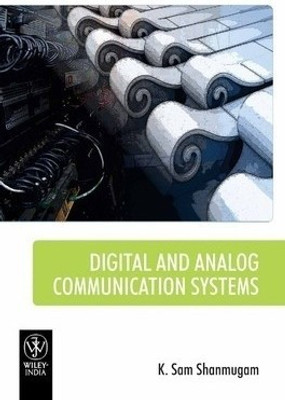Digital and Analog Communication Systems(English, Undefined, Shanmugam K. Sam)
Quick Overview
Product Price Comparison
The book gives a unified treatment of theoretical and practical aspects of digital and analog communication systems, with emphasis on digital communication systems. It integrates theory with design, keeping theoretical details to a minimum, with over 60 practical and worked examples illustrating real-life methods. The emphasis is mainly on deriving design equations that relate performance of functional blocks to design parameters. It illustrates how to trade off between power, bandwidth and equipment complexity while maintaining an acceptable quality of performance. The material is arranged into three different study areas, a review section, the study of digital communication systems, and the study of analog communication systems. The book also includes over 300 problems and an annotated bibliography in each chapter. Special Features The main focus is on the design and analysis of functional blocks in the system. There is consistent progression from concepts to design considerations without getting mired in too many theoretical details. Proofs of theorems are given wherever necessary. An outline of proofs with adequate references is also presented. Each chapter contains a number of examples and exercises for the student. The examples and problems cover practical and theoretical aspects of analysis and design of communicative systems. Supplementary material including tables of mathematical relationships and other numerical data are included in┬Ā 5 appendixes A to E: Appendix A: History of Electrical Communication Appendix B: Broadcast Frequency Bands Appendix C: Trigonometric Identities and Fourier Transforms Appendix D: Gaussian Probabilities Appendix E: Glossary of Symbols, Notations and Abbreviations About┬Ā The Author Dr K. Sam Shanmugam is the AT&T Distinguished Professor of Electrical Engineering and Computer Science at University of Kansas. He did his ME from IISc, Bangalore and Ph.D. from Oklahoma State University. Dr Shanmugam is the recipient of many honors and awards. He is also the professional member of Eta Kappa Nu, Phi Kappa Phi & IEEE, and Fellow. Table Of Contents 1 INTRODUCTION 1.1 Model of a Communication System 1.2 Elements of a Digital Communication System 1.3 Analysis and Design of Communication Systems 1.4 Organization of the Book 2 SYSTEMS AND SIGNAL ANALYSIS 2.1 Systems and Signals 2.2 Signal Representation Using Fourier Series 2.3 Signal Representation Using Fourier Transforms 2.4 power Spectral Density 2.5 System Response and Filters 2.6 Spectral Analysis of Modulation and Demodulation Operations 2.7 Spectral Measurements and Computations 2.8 Summary References Problems 3 RANDOM SIGNAL THEORY 3.1 Introduction 3.2 Introduction to Probabilities 3.3 Discrete Random Variables 3.4 Continuous Random Variables 3.5 Random Processes 3.6 Systems and Random Signals 3.7 Noise in Communication Systems 3.8 Summary References Problems 4 INFORMATION AND CHANNEL CAPACITY 4.1 Introduction 4.2 Measure of Information 4.3 Encoding of the Source Output 4.4 Communication Channels 4.5 Discrete Communication Channels 4.6 Continuous Channels 4.7 Summary References Problems 5 BASEBAND DATA TRANSMISSION 5.1 Introduction 5.2 Baseband Pulse Shaping 5.3 Duobinary Baseband PAM System 5.4 M-ary Signaling Schemes 5.5 Shaping of the Transmitted Signal Spectrum 5.6 Equalization 5.7 Miscellaneous Topics 5.8 Summary References Problems 6 ANALOG SIGNAL TRANSMISSION 6.1 Introduction 6.2 Analog Baseband Signal Transmission 6.3 Linear CW Modulation Schemes 6.4 Angle Modulation 6.5 Frequency Division Multiplexing 6.6 Commercial Broadcasting 6.7 Summary References Problems 7 NOISE IN ANALOG COMMUNICATION SYSTEMS 7.1 Introduction 7.2 Noise in Baseband Systems 7.3 Noise in Linear CW Modulation Systems 7.4 Noise in Angle Modulation Systems 7.5 Preemphasis/Deemphasis Filtering in CW Modulation Systems 7.6 Interference in CW Modulation 7.7 Comparison of CW Modulation Schemes 7.8 Summary References Problems 8 DIGITAL CARRIER MODULATION SCHEMES 8.1 Introduction 8.2 Optimum Receiver for Binary Digital Modulation Schemes 8.3 Binary ASK Signaling Schemes 8.4 Binary PSK Signaling Schemes 8.5 Binary FSK Signaling Schemes 8.6 Comparison of Digital Modulation Schemes 8.7 M-ary Signaling Schemes 8.8 Synchronization Methods 8.9 Summary References Problems 9 ERROR CONTROL CODING 9.1 Introduction 9.2 Linear Block Codes 9.3 Binary Cyclic Codes 9.4 Burst-Error-Correcting Modes 9.5 Burst- and Random-Error-Correcting Codes 9.6 Convolutional Codes 9.7 Performance of Block Codes?Error Correction 9.8 Performance of Block Codes?Error Detection 9.9 Summary References Problems 10 DIGITAL TRANSMISSION OF ANALOG SIGNALS 10.1 Introduction 10.2 Sampling Theory and Practice 10.3 Quantizing of Analog Signals 10.4 Coded Transmission of Analog Signals 10.5 Time-Division Multiplexing 10.6 Comparison of Methods for Analog Signal Transmission 10.7 Summary References Problems APPENDIX A: History of Electrical Communication APPENDIX B: Broadcast Frequency Bands APPENDIX C: Trigonometric Identities and Fourier Transforms APPENDIX D: Gaussian Probabilities APPENDIX E: Glossary of Symbols, Notations, and Abbreviations INDEX


